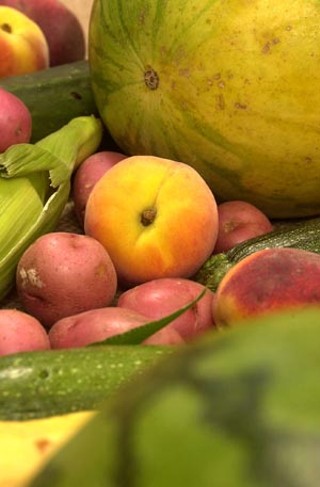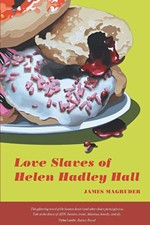Eating Fresh in Texas
Local foodies are reveling in a festival of produce
By Barbara Chisholm, Fri., June 22, 2007
They announced themselves as I was about to round the corner in the produce section, the aroma signaling their arrival before they were spotted: Texas peaches are here. Smaller and less attractive than their cousins from far-off regions nestled symmetrically in tidy boxes, the local versions are a jumbled lot of fragrant jewels. Their appearance confirms what I announce every year: "This is the best time to eat in Texas!"
If eating could be forgone until now, I might consider it. Sure, I'd want a Thanksgiving feast and Christmas dinner and probably all the brunches, buffets, and canapés in between. And when the first, long-awaited blue norther finally arrives, I eagerly tuck in to a steaming bowl of slowly simmered soup with a crusty chunk of bread. And on my birthday I await a buttery cake with the same anticipation as celebrants decades younger. But if I had to choose (and I'm relieved I don't), I'd opt for early and midsummer over other times to eat here. It's the time in Texas when the bounty of the land makes its way into supermarkets and farmers' markets (and the places in between); when the eatin' is juicy and delicious.
More temperate climates are just on the edge of summer eating. August issues of food magazines sport images of tomatoes and corn and feature articles on outdoor grilling. August in Austin means dried-up fields, withered vines, and searing temperatures that, if we're lucky, cool off to 80 degrees by 3am. There ain't a homegrown tomato that hasn't succumbed to the beastly heat, and the idea of standing over hot coals to cook a hunk of meat or fish or vegetables has all the allure of a dip in a tar pit. August in Texas is like January in Iowa: barren. But in June, we're experiencing summer harvest at its finest, and thanks to the plenitude of rain this year, it's at its fullest, too.
Squash
There's the typical avalanche of squash; apparently even the most amateurish gardener can grow crookneck and zucchini. At least, that's the word on the street (or rather in the garden.) Squash is one of those foods that doesn't exactly inspire devotion; its subtle taste and gentle texture are rarely reviled by anyone, either. But there are few who don't feel fried zucchini makes for tasty appetizers. I admit that there aren't many things that aren't improved by a dip in batter and a swim in some hot fat. Still, squash doesn't have to be fried to be appreciated. A seasonal sauté brings out its simple sweetness. Painted with olive oil and grilled, it's a summer side dish worthy of whatever protein anchors the meal. Local growers are expanding to more exotic varieties, and a squash harvest during this time of year looks like a Renaissance still-life painting. Gorgeous golden zucchini, whimsically shaped pattypan, and multicolored varieties are in abundance. I picked up a squash with a ridiculously long neck from the farmers' market that the grower told me was grown from some seeds he picked up in Italy.
Berries
Blackberry season is woefully short, but when it's in full flower as it is now, every bowl of cereal, ice cream, yogurt, etc. is topped with the plump beauties. The season should last about 10 more minutes before it's over, so now is the time to throw them into muffins and cobblers and smoothies, and if you have the room, freeze them for future use. When I spot blackberries at the grocer's, it's almost as good a find as discovering them in a bush. They're impossible to resist. When she was a little girl in her Easter-best yellow dress, my niece Cate came upon a berry-bearing bush in her back yard. Certain that her mother would appreciate nothing more than a fistful of the delicious treats, she stuffed her pockets full of the purple-black berries. What my sister received was a handful of tasty mush and a hopelessly stained dress.
Blueberries, too, are just starting to show up and will be around through July or even later. Currently, they're priced about the same as a barrel of crude oil, but it should be dropping soon. It's at that time that we pick up multiple boxes at a time. One box is just for eating on the ride home. The others find their way into pancakes and muffins and fruit bowls and cobblers. Blueberries are a relatively new crop to Texas; the majority of them are still grown in the cooler climes of Maine and the Upper Midwest.
My mom tells of her solo journey north to meet her in-laws during World War II. My dad was out fighting in the Pacific and had asked that she do him the one favor of going to meet his family in his absence. Seems they hadn't quite gotten around to that, what with their whirlwind romance and wedding and being stationed in Hawaii near Pearl Harbor. When the events of Dec. 7, 1941, assured my mom plenty of time on her own, she obliged my dad and journeyed north by train to Marquette, Mich. There she met her new family and began relationships that were sealed, among other things, by meal preparations. Her new grandfather was a retired chef at a grand hotel and spent his days shopping for and preparing meals. It was here that my mother first tasted the exotic blueberry, served to her in a pancake.
Fifty years later, she was amazed to find a Texas variety of the berry in stores. As in all things Texas, our version of the blueberry is considerably larger than the kind grown elsewhere. Some argue this doesn't necessarily make for a better berry, but try telling that to a Texan. The berry's popularity has soared in recent years on account of its antioxidants and high fiber content. It's sturdier than the delicate blackberry, too. Oh yeah, they're absolutely delicious, too. It took some noodling to find a berry that would thrive in our summers, but East Texas has the correct acidic, sandy soil in which the berries thrive, and the crop has become hugely popular, spawning a festival in Nacogdoches and plenty of pick-your-own opportunities.
Corn and Potatoes
While there's nothing uniquely Texan about the starchy staples of corn and potatoes, they're beloved anchors of the diet.
Corn is so prevalent, it's hard to remember it's a seasonal crop. There's nothing that speaks of the season more than a whole cob on a plate, dripping with butter. But it's one of those pesky crops that begins deteriorating as soon as it's picked. Oh, it doesn't visibly spoil, which is why we see stacks of stalks in grocery stores all summer long. But the starch begins accumulating, and the quality diminishes rapidly. Lore is that farming families put the kettle on to boil and send the kids out to pick the corn only after the water's boiling. The rest of us have to content ourselves with serving it the day we procure it.
Not so with the spud. We can keep them on hand for several days before they sprout and go downhill. The French chef Joel Robuchon realized that "if you give the people potatoes, potatoes, and more potatoes, they'll be eternally grateful, forever fulfilled." What's "new" about them I don't know, but little red potatoes are being dug up around here now and are so tender and delicious they simply need a short steam to cook. Tossed with some top-shelf butter and salt, they are perfection.
Tomatoes
Tomatoes are available year-round, and in most months their primary contribution to a sandwich or salad is to bring the wet to the dish. And some anemic color. It's always startling to eat the first honest-to-goodness homegrown tomato of the year. Oh yeah! That's the assertive flavor that can go mano a mano with bacon. Bacon: the Germany of foods that dominates everything around it ... except for a perfectly ripe, in-season tomato. During this season, a BLT – the sandwich staple of greasy spoons and low-rent diners everywhere – becomes a dish of divine proportions. It's also the time to whirl up some gazpacho and slice a simple Caprese salad before the heat consumes the treats. For Texans, the starter gun has gone off, and tomato season is here, so befriend your tomato-growing neighbor.
Melons
Watermelons, of course, are a party in a plant. There's something so portable, so contained, so festive, so summer about the fruit. They're such a treat; they elicit glee from kids, who are admonished to only eat them outside, as they cause such a mess. Adults shoot them up with vodka or whir them in cocktails. The color contrast of the red interior against the green rind makes it the easiest way to beautify a plate of sliced fruit. Then there's the yellow variety, an exotic creature I hadn't laid eyes on until I was engaged to my fifth-generation Texan husband and went to his family's reunion in Gilmer in 1987. It was there on the buffet, amid the okra and the corn and the barbecue and the dozens of pies, that I first beheld a yellow watermelon. I wondered if it was simply under-ripe, but my future mother-in-law marveled at my unfamiliarity and assured me it was just a melon, silly! The yellow variety actually tastes a lot like the common red ones, but they're a visually compelling addition or alternative. Bring a watermelon to a potluck, and you've brought the party. Valley farmers truck up melons by the, well, truckload all summer long. They're in virtually every grocery store or in the backs of many a truck-bed all along Texas highways.
Peaches
And then there are peaches: the most sensuous and seductive of fruits. It's my theory that God didn't tempt Adam and Eve with peaches because he figured with apples there was at least the possibility they wouldn't eat 'em. When a person is presented with a luscious, ripe peach, it's irresistible. The soft fuzz is like that of the down of a beautiful cheek. The golden/pink/red color, too, is fleshlike. The aroma of ripe peach can be detected from a foot or more away. Peaches are just flat-out sexy. In the Anna Deavere Smith play House Arrest, the American chef and restaurateur Alice Waters is a character. In a verbatim re-creation of what she said in an interview, Waters describes the ideal meal she would serve to President Clinton if she had her druthers. "I had thought that I wanted to give him the one peach dinner if he ever came to the restaurant. I had sort of fantasized about that 'cause it's the most seductive thing I could think of. I would just give him peaches in every form." It's enough to make one blush! We're at the beginning of what promises to be a great Hill Country season of peaches, so they should be available for weeks to come. As if the beauty of the Hill Country wasn't enough to lure you out of town, there's the promise of stopping at one of the dozens of fruit stands that populate Highway 290 and returning with a half or full bushel of peaches.
Going to the Market
These are, of course, just a smattering of the goods grown in Texas these days. Beans, beets, lettuces, cucumbers, and herbs are in abundance now. Pecos melons will be coming a bit later, and July 15 officially begins Gulf shrimp season. The list goes on and on. The freshest source of the season's best is in one's own garden, or so I'm told. I wouldn't know for certain; I have a genius for killing the most robust of plants. Really, an English ivy and hackberry tree met their demise at my hands. For this reason I'm filled with awe and gratitude when a friend gives me some of the bounty of his or her garden.
Farmers' markets are the next best thing to growing your own, and Austinites are doing their shopping with increasing numbers at the Sunset Valley and Downtown markets. The Triangle on Lamar and Guadalupe just started a weekday market, too, and smaller veggie stands are spotted in various locations. I love farmers' markets and wish I shopped there more often. What doesn't always work for me are the hours: Saturdays are my days to sleep in, and I don't often get up and out before the goods are gone. What I long for is Slackers Market for the performers and partiers in town, a market that would get under way at the nightlife-friendly hour of 3pm or so.
Meanwhile, Austin is nothing if not lousy with great grocery stores. The economy and zeitgeist is perfectly suited to neighborhood markets, and the owners are usually inclined to stock locally procured produce. The variety might be limited, but it's likely to be as fresh and local as at Whole Foods and Central Market. Both take pains and pride in partnering with local farmers and educating consumers about the sources of the food they sell. Signs above produce don't just announce the variety, but the growing conditions of the goods (organic or conventional) and the name of the farm on which they were grown.
Shopping at slick superstores can be intimidating to shoppers whose concern for what they eat is as important as the convenience and price. For a person on a tight timeline to get toilet paper, dish soap, and the familiar brand of instant tea in addition to groceries, making an additional stop at a conventional store can make a gourmet store trip impractical. And there's a price to be paid at the checkout for the slick lighting and exquisite goods of a Whole Foods or Central Market. Which makes sighting Texas produce at conventional HEBs so gratifying. In a ringing endorsement of the quality, quantity, and commitment of Texas growers, local produce can be found at your closest HEB. A recent dinner featured Texas-grown green beans, new potatoes, blackberries, and peaches all purchased at the decidedly funky HEB at South Congress and Oltorf.
Many mornings, my first thought upon waking is, "What am I going to eat today?" I wish that were only true during certain times of year, but who am I kidding? I love to eat just about every damn day: Sometimes three or more times in one day! And seasonal or not, I'm going to stock fresh fruit and vegetables in my refrigerator. It's especially mouthwatering to realize when I wake up that not only am I going to eat today, but that I'm chowing down during the best time to eat in Texas. ![]()
Summer Squash Sauté
¼ cup (½ stick) butter
1 1015 onion, thinly sliced
2 tablespoons chopped garlic
2 tablespoons chopped fresh tarragon or Mexican marigold
1 red pepper, sliced into thin strips
1 pound yellow crookneck or other squash, trimmed, sliced into 1/3-inch-thick rounds
1 pound small zucchini, trimmed, sliced into 1/3-inch-thick rounds
Preparation
Melt butter in large skillet over medium-high heat. Add onion, garlic, red pepper, and tarragon; sauté until onion is just tender, about two minutes. Add yellow squash and zucchini; sauté until crisp-tender, about eight minutes. Season with salt and pepper.
Gazpacho Salad
(A favorite from my sister-in-law Susie, who claims that cucumber is the smell of summer. I puree the leftovers with tomato juice to make gazpacho.)

6 tomatoes, seeded
3-4 cucumbers, peeled, seeded, and diced
4 green or red peppers, seeded and diced
2 onions, chopped
2 dozen kalamata olives, sliced
2 avocados, chopped
Vinaigrette:
4 garlic cloves
generous pinch of ground cumin
1 cup white-wine vinegar
1 cup olive oil
4 tablespoons chopped fresh parsley, divided
1 small shallot, diced
½ lemon
Preparation
Gently mix veggies and toss with salt and pepper. In small bowl, mash garlic with cumin and salt to paste. Whisk in vinegar, then add oil in steady stream to emulsify. Stir in 2 tablespoons parsley and shallot. Pour dressing over salad and chill 2-3 hours. Before serving, sprinkle with fresh lemon juice and additional chopped parsley. – B.C.
Peach/Blackberry Crisp
1½ pounds peaches (about 5), pitted and cut into chunks
2 cups blackberries (or blueberries later on), picked over and rinsed
1 tablespoon cornstarch
2 tablespoons fresh lemon juice
1/3 cup granulated sugar
2/3 cup all-purpose flour
¾ cup firmly packed light-brown sugar
½ cup old-fashioned rolled oats
½ teaspoon salt
1 teaspoon cinnamon
½ teaspoon freshly grated nutmeg
3/4 stick (6 tablespoons) cold, unsalted butter, cut into bits
3/4 cup coarsely chopped, lightly toasted pecans
Blue Bell homemade vanilla ice cream as an accompaniment
Preparation
In a large bowl, toss the peaches and the blackberries gently with the cornstarch, the lemon juice, and the granulated sugar until the mixture is combined well. In a small bowl stir together the flour, brown sugar, oats, salt, cinnamon, and nutmeg. Add the butter, blending the mixture until it resembles coarse meal, and stir in the pecans. Spread the peach mixture in a 13-inch-by-9-inch (3-quart) baking dish, sprinkle the pecan mixture evenly over it, and bake the crisp in the middle of a preheated 350-degree oven for 45 to 50 minutes or until the top is golden. Serve the crisp with the ice cream.









